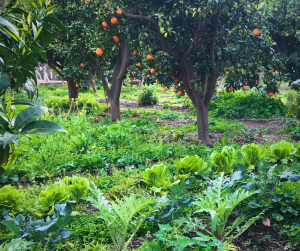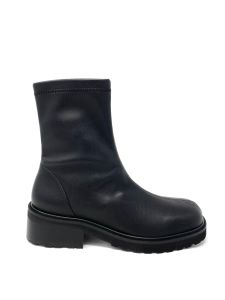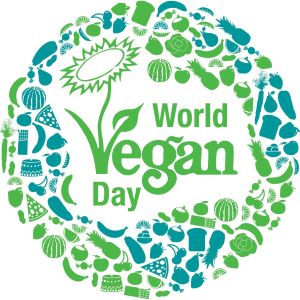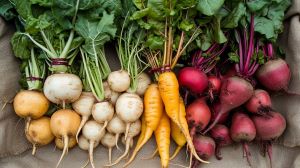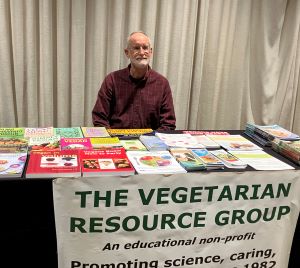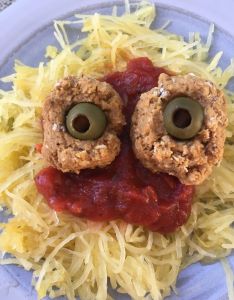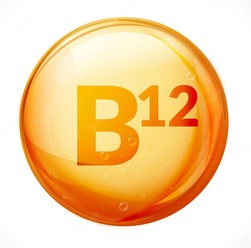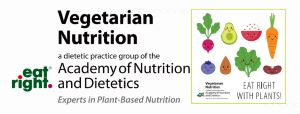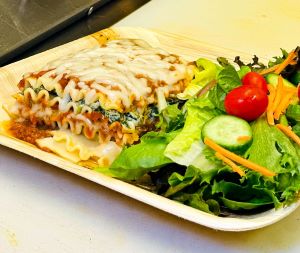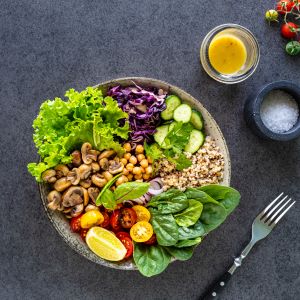Perennial Vegetables as a Climate Solution: Part 1 in a Series on Climate Foods
By Jeanne Yacoubous, MS
As the climate crisis unfurls wildfires and floods all over the world, traditional agriculture is under threat. People everywhere are already feeling the sting of higher prices for several popular foods including coffee and chocolate. Increasingly low crop yields in numerous countries mean food security about basic dietary staples such as wheat, rice, and corn is becoming a major concern.
In fact, scientist Kai Kornhuber and colleagues warned in research published in 2023: “Synchronized crop failures due to simultaneous weather extremes across multiple breadbasket regions pose a risk to global food security and food system supply chains.”
One way to alleviate food worries as well as mitigate your reliance on grocery stores is to grow at least some of your own food. The VRG’s recent article on veganic gardening offers lots of helpful tips for new as well as experienced gardeners.
Here, we focus on perennial vegetables (PVs) as an undiscovered, nutritional treasure that can expand your culinary horizons while they sequester carbon continually for years – if not decades – and produce abundant yields.
Perennial vegetables as a climate solution
Scientists have reported for decades that anthropogenic (human-caused) greenhouse gas (GHG) emissions caused by fossil fuel burning create the climate crisis which will continue to intensify as long as emissions continue to increase. To curb the heatwaves, wildfires, flooding, extreme drought, and sea level rise, fossil fuel burning must be drastically reduced – or end completely.
Although emissions from transportation and home heating represent the largest share, agriculture also contributes significantly to total GHG emissions. By one estimate, food production and the land use changes it requires, such as deforestation to make way for cattle grazing or farmland to grow more animal feed, are responsible for 28% of global GHG emissions.
Unfortunately, research published in September 2024 indicates that agriculture’s portion of global GHG will grow. Lead author Yi Yang and colleagues write: “Climate change will likely exacerbate the already large environmental impacts of agricultural production…agriculture’s response to climate change could create a powerful positive GHG feedback loop through multiple pathways…”
So, solving the climate crisis must involve several lifestyle changes, including dietary modifications.
The carbon footprints of food are a metric used to describe the greenhouse gas emissions associated with the production of that food. Animal foods have the largest carbon footprints while plant foods have the smallest. People who would like to lower their climate impact may do so by choosing foods that have lighter carbon footprints.
Another strategy to mitigate the climate crisis is to draw down greenhouse gases, including carbon dioxide, from the atmosphere and sequester them in soil. Growing perennial vegetables in your garden for food is one way to accomplish this.
What are perennial vegetables?
According to Eric Toensmeier et al., perennial vegetables (PVs) are woody, herbaceous, or vining plants that are among “613 cultivated perennial vegetables, representing 107 botanical families from every inhabited continent…Perennial vegetables (PVs) are a neglected and underutilized class of crops with potential to address crises of crop biodiversity, climate change, and nutrient deficiencies. ”
As a functional definition of PVs, the investigators propose these criteria:
- Lives for 3+ years
- May be woody, herbaceous, or vining
- Could be a perennial fruit eaten like a vegetable
- Compatible with no-till perennial production systems
Perennial vegetables that are best at sequestering carbon
All plants do not sequester carbon equally. Perennial plants – those that regrow each year instead of dying off after the first frost – sequester carbon longer than annual plants because their ability to store carbon is longer in roots that continually grow deeper and wider for years if not decades.
Edible perennial plants are known as perennial foods. Here, we’ll focus on growing perennial vegetables (PVs).
To the best of our knowledge, there is not a complete list of perennial vegetables ranked by carbon sequestration ability, but a 2020 article by Eric Toensmeier et al. provides useful information. Based on numerous articles on certain tree or plant species which have included experimentally calculated carbon sequestering abilities, the investigators found that woody perennial vegetables sequester the most carbon compared to herbs and vines. They expressed this value in terms of tons of carbon per hectare per year.
More specifically, Toensmeier and colleagues found “the average rate for woody PVs is 3.7 tC/ha/yr, while that of perennial vines and herbs is 0.43 tC/ha/yr/.”
For a complete listing of the 613 cultivated, perennial vegetables identified by Toensmeirer and colleagues and additional tables of their nutritional profiles, see the supplementary information at the end of their 2020 article.
Long-rooted perennial vegetables
Generally, the nonprofit Plants for a Future writes that perennial plants with long, wide roots store more carbon, for longer, in deeper carbon pools in soil. So, we looked for perennial plants that are edible and have the deepest roots. Here are a few deep-rooted perennials:
- Cardoon. According to Oregon State University, “The young tender leaf mid-ribs and immature flower stalks are used. The plant hearts are sometimes blanched like celery stalks (maturing in September).” Oregon State University Extension Service
- Stinging Nettle. According to the Oregon State University Extension Service, “Roots, seeds, stems, and young, tender leaves are all edible.”
- Dandelion. According to the Michigan State University Extension Service, “Nearly the entire plant can be consumed in one way or another. The only inedible part is the stem, which contains a very bitter, milky substance.”
- Moringa. According to the United Nations Food and Agriculture Organization: “All parts of the moringa tree – bark, pods, leaves, nuts, seeds, tubers, roots, and flowers – are edible.”
Perennial vegetables
You’re probably familiar with asparagus, rhubarb, and globe artichoke, and may have even eaten or cooked with them. Do you know that they are all perennial vegetables?
If these vegetables already have a place in your garden, then introducing more perennials will only further complement the annuals – such as tomatoes, zucchinis, and cucumbers – that last only one season. With perennials, you can easily extend your harvest to all four seasons without replanting. Ever.
Unlike most garden annuals that require full sun and well-drained soil to thrive, the majority of perennials grow well in full shade, water-logged soil, or without fertilizer or irrigation (except under extremely arid conditions). Perennials are low-maintenance to grow. However, years-long neglect would likely result in their becoming weedy, so it’s important to harvest frequently.
Although many perennials are most suited to warmer regions, several do well in cold areas as annuals. In future parts of this series, we’ll discuss those perennials for Northern gardeners as well as many others that will succeed in warmer locales.
Types of perennial vegetables
By way of a general introduction to the wide variety of perennial vegetables hailing from all corners of the globe, here’s a sneak peek at some of the most interesting, highlighting their edible parts as described in Eric Toensmeier’s classic book titled Perennial Vegetables.
Edible leaves
Most perennial vegetables, including those from trees, shrubs, and woody vines, have edible leaves, stems, and leafstalks.
Example: water celery. Thriving in a water garden or on land (sunny or shady), water celery is a leafy green that really tastes like celery.
Edible shoots
Perennial vegetables with tender, new growth emerging in spring as shoots are edible.
Example: asparagus. Considered the classic harbinger of spring, asparagus is served as a fine delicacy the world over.
Edible fruits eaten like vegetables
Tomatoes and eggplants are annual fruits prepared and eaten like vegetables. Some perennials fit this category as well.
Example: chayote. Fruits grown on a vine, chayote are used like zucchini.
Edible pods and beans
Perennial legumes often yield edible pods and beans.
Example: scarlet runner bean. Easily yielding for two decades, these beans succeed in a few North American regions.
Edible flowers and buds
Perennial vegetables could be the flowers or flower buds of plants, analogous to broccoli and cauliflower.
Example: globe artichoke: Like the perennial asparagus, globe artichoke is gourmet but can grow in your garden.
Edible roots
Some perennials are root crops that form vast, underground colonies that persist for decades.
Example: sunchoke (Jerusalem artichoke). With a name similar to its sunflower relative, sunchokes have sweet and crispy roots.
Airborne roots
Perennial vegetables may be tubers (like yams) growing above ground on vines.
Example: air potato. No digging required to get to this root crop! Sized like a medium potato, air potatoes grow on climbing vines and can be picked just like apples or pears.
Perennial gardening books
To learn more, check out:
A Global Inventory of Perennial Vegetables by Eric Toensmeier
Global Gardening: Increasing the Diversity of Plants in Your Own Garden While Feeding a Hungry World by Hank Bruce and Tomi Jill Folk
Gourment Gardening: 48 Special Vegetables You Can Grow for Deliciously Distinctive Meals by Anne Halpin
Plants for a Future: Edible & Useful Plants for a Healthier World by Ken Fern
by John Jeavons
Perennial plant seed companies
There are not too many places that sell perennial vegetable plants and seeds. Many listings are outdated. Here are a few that are currently operational and have online sales:
Educational Concerns for Hunger Organization (ECHO)
